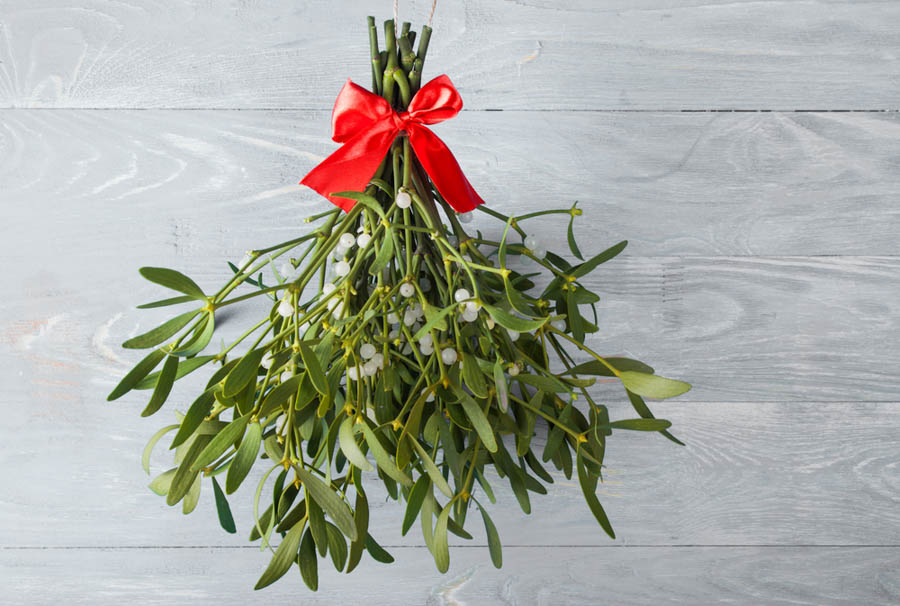A Holiday Kiss Under the…Holly?: Mistletoe for The California Holidays, Part 1 of 3

A holiday kiss under the mistletoe may be just the thing if you’re hoping for luck in love, a peaceful new year, or merely a second date, at least if you’re willing to rely on age-old folklore and legends. But be careful! If you want that kiss to be effective, make it happen under mistletoe, not holly.
Holly and mistletoe continue to be confused, with images of holly being used more often than you might expect to illustrate or depict mistletoe across a wide variety of media and products. Maybe it’s the dreamy holiday glow beguiling shoppers and affecting the judgment of professional fact-checkers, or the lack of botanical knowledge among the general public, or perhaps in part it’s the more-dynamic appearance of holly that may boost sales as compared to the relatively plain mistletoe. In preparing this article, I easily found prominent websites, top images on major search engines, respected nationwide news sources, greeting cards, popular sources for clip art, clothing, and more all depicting what appear to be holly leaves with red berries but calling it mistletoe. Even those unconcerned with holiday romance may want a reasonable level of botanical authenticity in holiday decorations.
The name “mistletoe” provides an excellent example of the confusion that arises in referring to plants by common name. “Mistletoe” may refer to potentially hundreds of different plant species from various genera and families. Historical, literary, or religious references to “mistletoe,” such as in folklore and legends, usually refer to European Mistletoe, Viscum album, which is native to Europe but also occurs in the United States and in California. The most widespread species of mistletoe in California is Broadleaf Mistletoe (Phoradendron leucarpum spp. macrophyllum).
Mistletoe species live in trees as parasites, their roots extending into the living tissues of trees, from which they obtain water and nutrients. Mistletoe produces white berries, with leaves that are oval or rounded in shape with smooth edges, and somewhat thick, similar to the leaves of succulents.
Holly species are trees or shrubs with their roots in soil. They produce red berries and waxy leaves that are serrated or spiny. If you’re worried about being poked by leaf edges, it’s not mistletoe.
You may see holly mixed with mistletoe in holiday decorations, or even incorrectly sold as mistletoe. In some cases, true mistletoe leaves may be sold but with red berries substituted, apparently for a brighter or more “Christmasy” appearance.
Kiss under the mistletoe but don’t eat it! All mistletoe species are toxic to varying degrees.
Mistletoe may be growing in your California neighborhood or even in your own backyard. Learn more in part 2 of this series: A Holiday Kiss Under the…Tree-Killing Parasite?: Mistletoe for The California Holidays, Part 2.
Don’t know your GardenZeus climate zone? Click here.
This is an updated version of an article originally published on December 7, 2017.
Other articles with holiday interest:
A Holiday Kiss Under the…Tree-Killing Parasite?: Mistletoe for The California Holidays, Part 2 of 3
Poinsettias: Tips, Care and Fun Facts for the Holidays
Gifts for Gardeners: Essential and Deluxe Tools for the Home Garden
Paperwhites for the California Holidays
Indoor and Potted Plants for the Holiday Season


